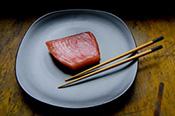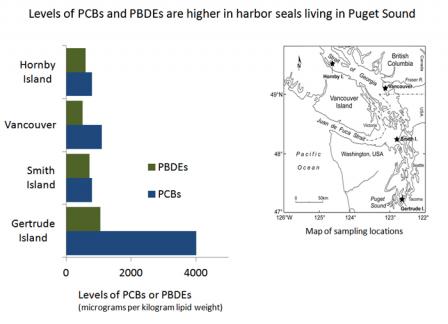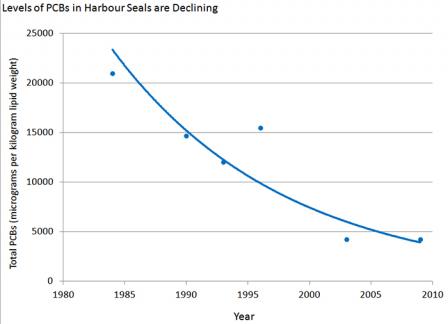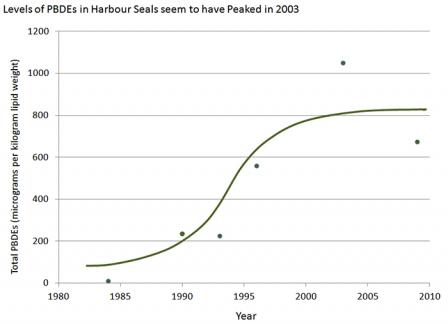Toxics in the Food Web: Pacific Herring and Harbor Seals
Summary
Improving
Levels of PCBs in harbor seals have been declining since the 1980s, though the decline has slowed in recent years. Levels of flame retardant chemicals - called PBDEs - are also declining in harbor seals.
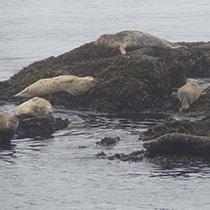
Pacific herring (Clupea pallasii) and harbor seals (Phoca vitulina) are two species that can help us determine the levels, trends and effects of certain types of pollution that are persistent, bioaccumulative, and toxic. These include polychlorinated biphenyls (PCBs) and polybrominated diphenyl ethers (PBDEs), which are commonly used to make fire resistant products.
- Learn more about Pacific herring and harbor seals
Pacific Herring
Pacific herring are small fish (up to 18 inches long, or 45cm) that are food for every large fish-eating species in the Salish Sea, including Pacific salmon, seals and orcas. These herring may be exposed to toxic contamination in the water and in the plankton they eat. Since they don't live long, the levels of contamination found in Pacific herring can tell us about recent environmental conditions and serve as an "early warning indicator" of toxic contamination.
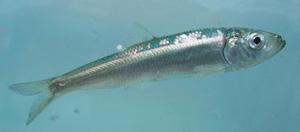 Pacific herring. Photo courtesy of NOAA Fisheries
Pacific herring. Photo courtesy of NOAA FisheriesHarbor Seals
Harbor seals are common throughout the Salish Sea. Since they're relatively long-lived (20-30 years), levels of contamination in harbor seals can show trends that help us determine the effectiveness of regulations and source control on reducing toxic pollution. Since they're near the top of the coastal food chain, they can also tell us about potential impacts to other top predators that are harder to measure, such as orcas.
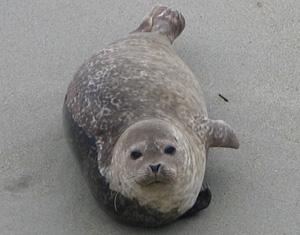 Harbor seal. Photo courtesy of NOAA.
Harbor seal. Photo courtesy of NOAA.
What's happening?
PCBs and PBDEs are found in all harbor seals of the Salish Sea, but levels are declining. Likewise, levels of PCBs and PDBEs in Pacific herring are generally declining or remaining stable. However, PCBs in herring in southern Puget Sound are above levels that may cause negative effects in the food web.
- Learn more about what's happening
Pacific Herring
PCBs and PBDEs are 6 to 7 times higher in herring sampled in the more urbanized and industrialized areas of central and southern Puget Sound than in herring sampled in the Strait of Georgia. Though levels of PCBs in herring from southern Puget Sound are above levels that may cause negative effects, they are not increasing. PCBs in herring in the southern Strait of Georgia are also not increasing.
PBDEs in herring are mostly below levels that may cause negative effects, and trends appear to be either declining or remaining stable.
Harbor Seals
PCBs and PBDEs are higher in harbor seals living in the more urbanized and industrialized areas of southern Puget Sound than in seals living in the Straits of Juan de Fuca and Georgia. The levels of PCBs are about four times higher than PBDEs, which highlights the tremendous persistence of PCBs in the environment. However, PBDE levels are still moderately high and are seen as a significant contaminant in harbor seals.
PCB concentrations have been declining in harbor seals, and levels of PBDEs appear to have peaked in 2003, following a previous rapid increase since 1984.
Why is it important?
PCBs and PBDEs disrupt the endocrine system (which produces hormones that regulate metabolism, growth, and tissue function, among other things) and have been associated with adverse health effects in laboratory animals, wildlife and humans. Evidence of these contaminants in Pacific herring and harbor seals suggests the potential for impacts to other species of the Salish Sea.
- Learn more about why it's important
There's evidence that PCBs are affecting the health of marine mammals in the Salish Sea. Altered thyroid hormone physiology, vitamin A levels, and immune function have been associated with PCB levels in local harbor seals. PCB-related changes in orca genes have also recently been reported.
There's currently no information about what level of PBDEs may cause negative effects in marine mammals, but their similar structure to PCBs suggests that similar effects can be expected at high enough doses.
Why is it happening?
The higher levels of PCB and PBDE found in harbor seals in southern Puget Sound is likely due to the more heavily urbanized and industrialized environment in those areas. However, improving PCB trends in harbor seals suggest that environmental regulations have been helping. More monitoring is needed to explain trends in PBDE levels as new regulations are being phased in.
- Learn more about why it's happening
Another likely factor in the elevated levels of PCB and PDBE in harbour seals and herring from southern Puget Sound is the semi-enclosed nature of Puget Sound. This area experiences limited tidal exchange and low sedimentation rates, which means that contamination doesn't get buried quickly and may remain in the food web for longer periods of time.
The rapid increase in PBDEs in harbor seals between 1984 and 2003 reflects the widespread use of three commercial formulations of this flame retardant chemical. These chemicals were used in textiles, electronics, and furniture to meet flammability standards. In 2009, scientists measured a reduction in PBDE levels in seals, but it's still too soon to know whether this reduction is in response to stricter controls and regulation of PDBEs.
What are we doing about it?
Regulations banning PCBs were enacted in the U.S. in 1976 and in Canada in 1977. In 2004, products containing some forms of PDBE (penta- and octa-) were voluntarily removed from the North American market. Another form of PBDE (deca-) is being phased out in the U.S. and Canada by 2013.
Five things you can do to help!
- Do your part to dispose of unused medicine and chemicals properly. Never dump into household toilets and sinks or outside where they can get into ditches or storm drains. See if your community has a household hazardous waste collection facility that will take your old or unused chemicals.
- Use beneficial landscaping techniques such as natural vegetation, rain gardens, rain barrels, green roofs and permeable paving to help reduce the need for chemical fertilizers and reduce runoff into ditches and storm drains.
- If you maintain your own car, dispose of oil and other auto wastes at your local recycling location or hazardous waste collection facility.
- Be sure your car is not leaking oil that can run off streets and into waterways.
- If you're a boater, make sure fuel goes only in your tank - not in the water. Don't fill your tank to capacity - leave room for expansion, especially during warm weather.
Related information
The following links exit the site Exit
- Marine Toxic Contaminants - Washington Dept. of Fish and Wildlife
- Puget Sound Fish Consumption Advisories
- NOAA Ecotoxicology and Environmental Fish Health Program
- Environmental Screening Assessment Report on PBDEs - Environment Canada
- State of the Science Report for PBDEs - Health Canada
Scientific references
The following links exit the site Exit
- Mos,L., Cameron,M., Jeffries,S.J., Koop,B.F., and Ross,P.S. 2010. Risk-based analysis of PCB toxicity in harbor seals (abstract). Integrated Environmental Assessment and Management 6: 631-640.
- Mos,L., Morsey,B., Jeffries,S.J., Yunker,M., Raverty,S., De Guise,S., and Ross,P.S. 2006. Both chemical and biological pollution contribute to immunological profiles of free-ranging harbor seals (abstract). Environ.Toxicol.Chem. 25: 3110-3117.
- Ross,P.S., De Swart,R.L., Addison,R.F., Van Loveren,H., Vos,J.G., and Osterhaus,A.D.M.E. 1996. Contaminant-induced immunotoxicity in harbour seals: wildlife at risk? (abstract) Toxicology 112: 157-169.
- Ross,P.S., Jeffries,S.J., Yunker,M.B., Addison,R.F., Ikonomou,M.G., and Calambokidis,J. 2004. Harbor seals (Phoca vitulina) in British Columbia, Canada, and Washington, USA, reveal a combination of local and global polychlorinated biphenyl, dioxin, and furan signals (asbstract). Environ.Toxicol.Chem. 23: 157-165.
- Tabuchi,M., Veldhoen,N., Dangerfield,N., Jeffries,S.J., Helbing,C.C., and Ross,P.S. 2006. PCB-related alteration of thyroid hormones and thyroid hormone receptor gene expression in free-ranging harbor seals (Phoca vitulina) (abstract). Environ.Health Perspect. 114: 1024-1031.
- More references
- West, J.E., O’Neill,S.M., Lanksbury,J., Ylitalo,G.M. and Redman,S. 2011. Current conditions, time trends and recovery targets for toxic contaminants in Puget Sound Fish in the Toxics in Fish Dashboard Indicator. Washington Department of Fish and Wildlife. Accessed March 8, 2012.
- Garrett, C.L. 2004. Priority substances of interest in the Georgia: profiles and background information on current toxics issues : report of the Canadian Toxics Work Group of the Puget Sound Georgia Basin International Task Force. ISBN 0-662-38526-8. Cat. no. Em84-7/2004E-HTML.
- Enkon Environmental Limited. 1999. Sources and Releases of Toxic Substances in Wastewaters within the Georgia Basin. Prepared for Environment Canada, North Vancouver, BC. Project Number 1004-003.
- Enkon Environmental Limited. 2002. Loading Estimates of Selected Toxic Substances in Wastewaters Discharged to the Georgia Basin, North Vancouver, BC. Project Number EC/GB-02-039.

